Evaluating Participation & Collaboration: School Age Care Practice
VerifiedAdded on 2023/04/11
|6
|1676
|249
Practical Assignment
AI Summary
This practical assignment presents an evaluation of 'Supporting Participation & Collaboration' within a school-age care setting, focusing on children aged 8-10 years. It uses the 'My Time, Our Place' framework to assess interests, strengths, and support needs of children like Mark and Daniel, emphasizing building relationships through interaction and scaffolding learning experiences. The evaluation identifies opportunities to extend children's interests, such as constructing an outdoor Indian village or organizing group sports, aligning with the MTOP: FSAC learning outcomes. It considers developmental factors, support needs, and strategies to encourage participation, while also addressing safety considerations and behavior expectations. The assignment further discusses the implementation of planned experiences, the evaluation process involving children, and suggestions for strengthening interests and relationships, reflecting on the pedagogy to support building and nurturing relationships and continuous learning.
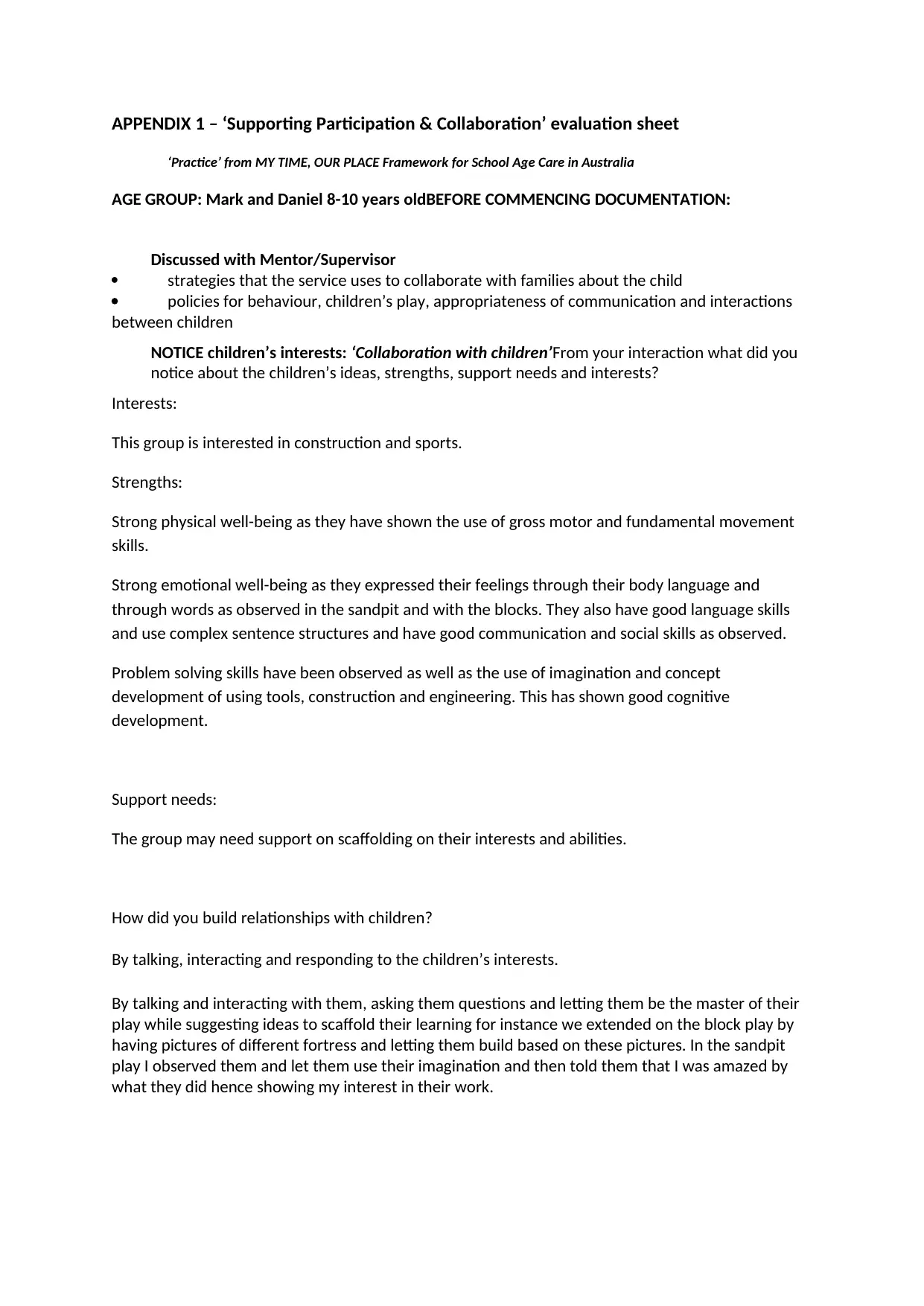
APPENDIX 1 – ‘Supporting Participation & Collaboration’ evaluation sheet
‘Practice’ from MY TIME, OUR PLACE Framework for School Age Care in Australia
AGE GROUP: Mark and Daniel 8-10 years oldBEFORE COMMENCING DOCUMENTATION:
Discussed with Mentor/Supervisor
strategies that the service uses to collaborate with families about the child
policies for behaviour, children’s play, appropriateness of communication and interactions
between children
NOTICE children’s interests: ‘Collaboration with children’From your interaction what did you
notice about the children’s ideas, strengths, support needs and interests?
Interests:
This group is interested in construction and sports.
Strengths:
Strong physical well-being as they have shown the use of gross motor and fundamental movement
skills.
Strong emotional well-being as they expressed their feelings through their body language and
through words as observed in the sandpit and with the blocks. They also have good language skills
and use complex sentence structures and have good communication and social skills as observed.
Problem solving skills have been observed as well as the use of imagination and concept
development of using tools, construction and engineering. This has shown good cognitive
development.
Support needs:
The group may need support on scaffolding on their interests and abilities.
How did you build relationships with children?
By talking, interacting and responding to the children’s interests.
By talking and interacting with them, asking them questions and letting them be the master of their
play while suggesting ideas to scaffold their learning for instance we extended on the block play by
having pictures of different fortress and letting them build based on these pictures. In the sandpit
play I observed them and let them use their imagination and then told them that I was amazed by
what they did hence showing my interest in their work.
‘Practice’ from MY TIME, OUR PLACE Framework for School Age Care in Australia
AGE GROUP: Mark and Daniel 8-10 years oldBEFORE COMMENCING DOCUMENTATION:
Discussed with Mentor/Supervisor
strategies that the service uses to collaborate with families about the child
policies for behaviour, children’s play, appropriateness of communication and interactions
between children
NOTICE children’s interests: ‘Collaboration with children’From your interaction what did you
notice about the children’s ideas, strengths, support needs and interests?
Interests:
This group is interested in construction and sports.
Strengths:
Strong physical well-being as they have shown the use of gross motor and fundamental movement
skills.
Strong emotional well-being as they expressed their feelings through their body language and
through words as observed in the sandpit and with the blocks. They also have good language skills
and use complex sentence structures and have good communication and social skills as observed.
Problem solving skills have been observed as well as the use of imagination and concept
development of using tools, construction and engineering. This has shown good cognitive
development.
Support needs:
The group may need support on scaffolding on their interests and abilities.
How did you build relationships with children?
By talking, interacting and responding to the children’s interests.
By talking and interacting with them, asking them questions and letting them be the master of their
play while suggesting ideas to scaffold their learning for instance we extended on the block play by
having pictures of different fortress and letting them build based on these pictures. In the sandpit
play I observed them and let them use their imagination and then told them that I was amazed by
what they did hence showing my interest in their work.
Paraphrase This Document
Need a fresh take? Get an instant paraphrase of this document with our AI Paraphraser
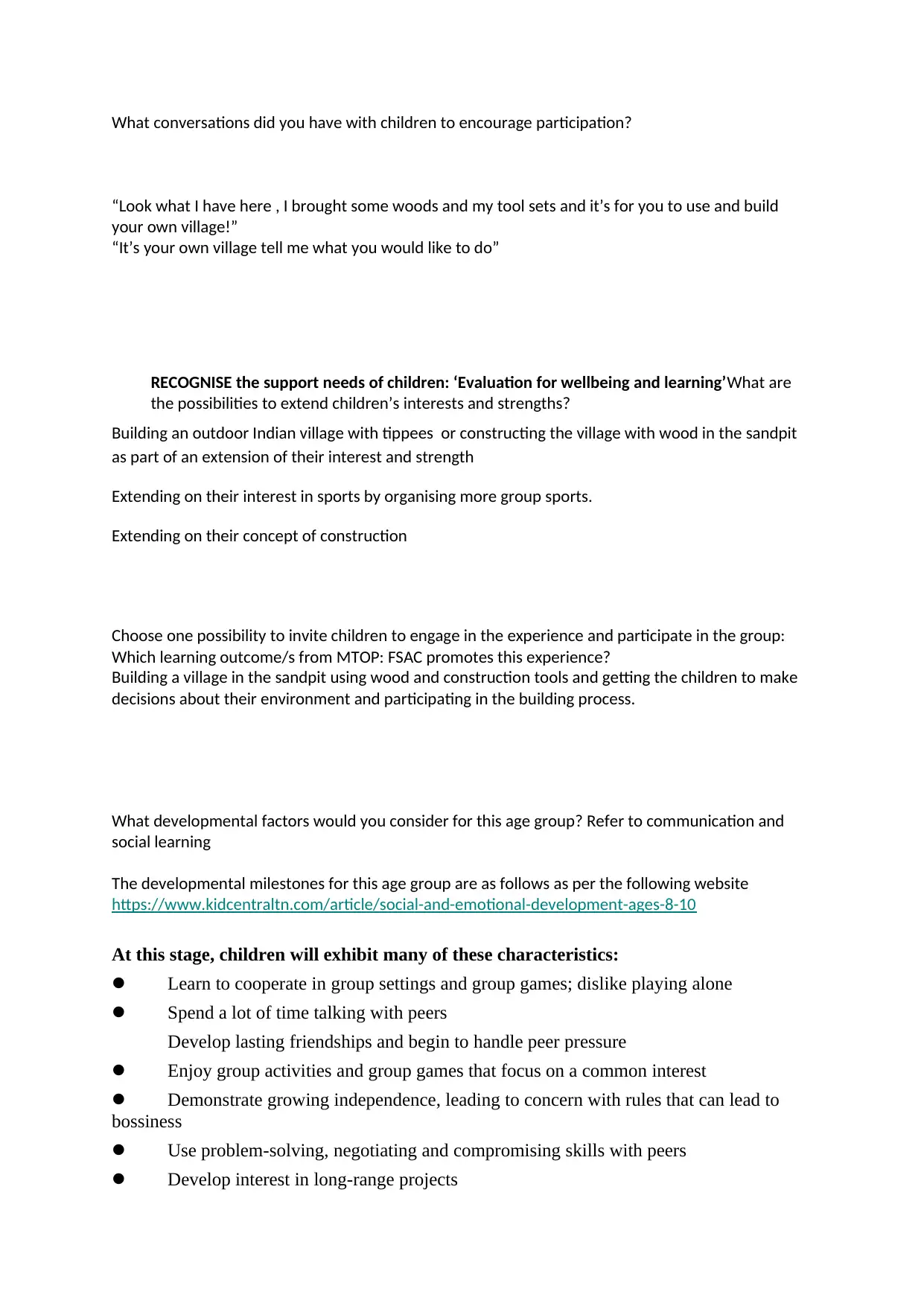
What conversations did you have with children to encourage participation?
“Look what I have here , I brought some woods and my tool sets and it’s for you to use and build
your own village!”
“It’s your own village tell me what you would like to do”
RECOGNISE the support needs of children: ‘Evaluation for wellbeing and learning’What are
the possibilities to extend children’s interests and strengths?
Building an outdoor Indian village with tippees or constructing the village with wood in the sandpit
as part of an extension of their interest and strength
Extending on their interest in sports by organising more group sports.
Extending on their concept of construction
Choose one possibility to invite children to engage in the experience and participate in the group:
Which learning outcome/s from MTOP: FSAC promotes this experience?
Building a village in the sandpit using wood and construction tools and getting the children to make
decisions about their environment and participating in the building process.
What developmental factors would you consider for this age group? Refer to communication and
social learning
The developmental milestones for this age group are as follows as per the following website
https://www.kidcentraltn.com/article/social-and-emotional-development-ages-8-10
At this stage, children will exhibit many of these characteristics:
l Learn to cooperate in group settings and group games; dislike playing alone
l Spend a lot of time talking with peers
Develop lasting friendships and begin to handle peer pressure
l Enjoy group activities and group games that focus on a common interest
l Demonstrate growing independence, leading to concern with rules that can lead to
bossiness
l Use problem-solving, negotiating and compromising skills with peers
l Develop interest in long-range projects
“Look what I have here , I brought some woods and my tool sets and it’s for you to use and build
your own village!”
“It’s your own village tell me what you would like to do”
RECOGNISE the support needs of children: ‘Evaluation for wellbeing and learning’What are
the possibilities to extend children’s interests and strengths?
Building an outdoor Indian village with tippees or constructing the village with wood in the sandpit
as part of an extension of their interest and strength
Extending on their interest in sports by organising more group sports.
Extending on their concept of construction
Choose one possibility to invite children to engage in the experience and participate in the group:
Which learning outcome/s from MTOP: FSAC promotes this experience?
Building a village in the sandpit using wood and construction tools and getting the children to make
decisions about their environment and participating in the building process.
What developmental factors would you consider for this age group? Refer to communication and
social learning
The developmental milestones for this age group are as follows as per the following website
https://www.kidcentraltn.com/article/social-and-emotional-development-ages-8-10
At this stage, children will exhibit many of these characteristics:
l Learn to cooperate in group settings and group games; dislike playing alone
l Spend a lot of time talking with peers
Develop lasting friendships and begin to handle peer pressure
l Enjoy group activities and group games that focus on a common interest
l Demonstrate growing independence, leading to concern with rules that can lead to
bossiness
l Use problem-solving, negotiating and compromising skills with peers
l Develop interest in long-range projects
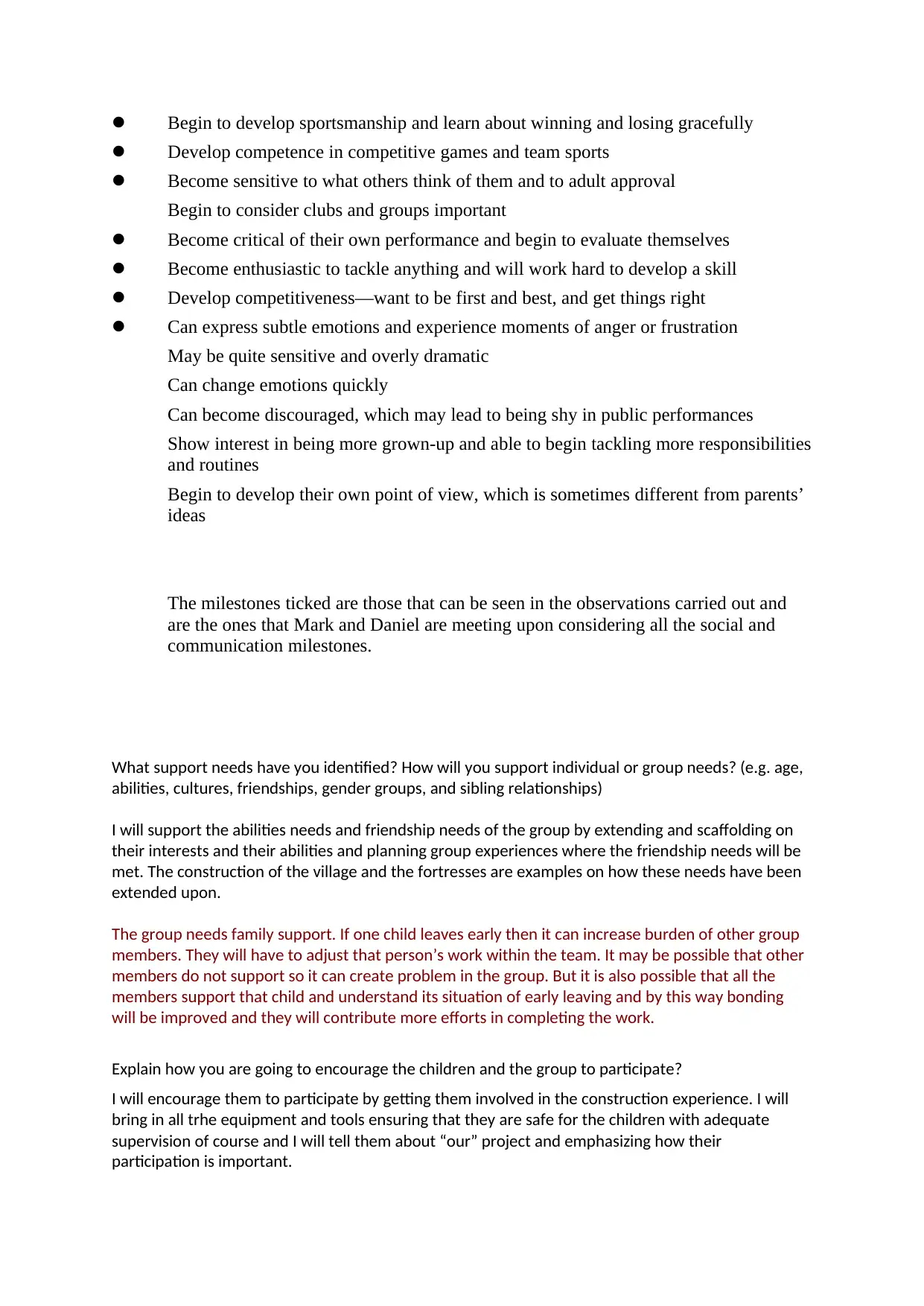
l Begin to develop sportsmanship and learn about winning and losing gracefully
l Develop competence in competitive games and team sports
l Become sensitive to what others think of them and to adult approval
Begin to consider clubs and groups important
l Become critical of their own performance and begin to evaluate themselves
l Become enthusiastic to tackle anything and will work hard to develop a skill
l Develop competitiveness—want to be first and best, and get things right
l Can express subtle emotions and experience moments of anger or frustration
May be quite sensitive and overly dramatic
Can change emotions quickly
Can become discouraged, which may lead to being shy in public performances
Show interest in being more grown-up and able to begin tackling more responsibilities
and routines
Begin to develop their own point of view, which is sometimes different from parents’
ideas
The milestones ticked are those that can be seen in the observations carried out and
are the ones that Mark and Daniel are meeting upon considering all the social and
communication milestones.
What support needs have you identified? How will you support individual or group needs? (e.g. age,
abilities, cultures, friendships, gender groups, and sibling relationships)
I will support the abilities needs and friendship needs of the group by extending and scaffolding on
their interests and their abilities and planning group experiences where the friendship needs will be
met. The construction of the village and the fortresses are examples on how these needs have been
extended upon.
The group needs family support. If one child leaves early then it can increase burden of other group
members. They will have to adjust that person’s work within the team. It may be possible that other
members do not support so it can create problem in the group. But it is also possible that all the
members support that child and understand its situation of early leaving and by this way bonding
will be improved and they will contribute more efforts in completing the work.
Explain how you are going to encourage the children and the group to participate?
I will encourage them to participate by getting them involved in the construction experience. I will
bring in all trhe equipment and tools ensuring that they are safe for the children with adequate
supervision of course and I will tell them about “our” project and emphasizing how their
participation is important.
l Develop competence in competitive games and team sports
l Become sensitive to what others think of them and to adult approval
Begin to consider clubs and groups important
l Become critical of their own performance and begin to evaluate themselves
l Become enthusiastic to tackle anything and will work hard to develop a skill
l Develop competitiveness—want to be first and best, and get things right
l Can express subtle emotions and experience moments of anger or frustration
May be quite sensitive and overly dramatic
Can change emotions quickly
Can become discouraged, which may lead to being shy in public performances
Show interest in being more grown-up and able to begin tackling more responsibilities
and routines
Begin to develop their own point of view, which is sometimes different from parents’
ideas
The milestones ticked are those that can be seen in the observations carried out and
are the ones that Mark and Daniel are meeting upon considering all the social and
communication milestones.
What support needs have you identified? How will you support individual or group needs? (e.g. age,
abilities, cultures, friendships, gender groups, and sibling relationships)
I will support the abilities needs and friendship needs of the group by extending and scaffolding on
their interests and their abilities and planning group experiences where the friendship needs will be
met. The construction of the village and the fortresses are examples on how these needs have been
extended upon.
The group needs family support. If one child leaves early then it can increase burden of other group
members. They will have to adjust that person’s work within the team. It may be possible that other
members do not support so it can create problem in the group. But it is also possible that all the
members support that child and understand its situation of early leaving and by this way bonding
will be improved and they will contribute more efforts in completing the work.
Explain how you are going to encourage the children and the group to participate?
I will encourage them to participate by getting them involved in the construction experience. I will
bring in all trhe equipment and tools ensuring that they are safe for the children with adequate
supervision of course and I will tell them about “our” project and emphasizing how their
participation is important.
⊘ This is a preview!⊘
Do you want full access?
Subscribe today to unlock all pages.

Trusted by 1+ million students worldwide

We can draw a plan together before starting the children can discuss and share their ideas for the
village and letting them use some of the tools for instance I can drill holes before hands in the wood
and let the children use the screwdriver with close supervision to give them a sense of agency.
What are the safety considerations and risk management strategies of your planned experience?
Adequate Supervision need to be maintained at all times and electrical tools with electric cords
should not be used. The tools being used shall be closely supervised and I need to ensure that limits
are set and followed.
Yes, it is possible to explore because they have good experience of working with real tools. Risk
benefit assessment will help to explore safety and will provide good opportunities to the children.
Further, they will be able to finish their work soon. Close monitoring and presence of expert in the
field will assist to reduce unsafe activities.
What behaviour expectations will you set before the children engage in the experience?
I will talk about the limits involved in this experience such as turn taking, listening ears and the
building equipments stay in the construction area.
What resources are required? What are the considerations for the costs involved?
Thin wooden pieces for the walls and small pieces to be screwed together for shelter in the village.
This will cost will be about $20 for the screws and the tools are available at the service and the wood
pieces were given by parents and staffs.
BEFORE IMPLEMENTATION:
Discussed with Mentor/Supervisor
the safety and risk management of your experiences
developmental behaviour guidelines and limits
any resources required and any costs involved
RESPOND to strengthen children’s interests and relationships: ‘Intentionality’
IMPLEMENT YOUR THREE (3) PLANNED EXPERIENCES: ‘Learning through play’How were the
children involved in the evaluation process?
Attach your evidence of their participation and collaboration.
village and letting them use some of the tools for instance I can drill holes before hands in the wood
and let the children use the screwdriver with close supervision to give them a sense of agency.
What are the safety considerations and risk management strategies of your planned experience?
Adequate Supervision need to be maintained at all times and electrical tools with electric cords
should not be used. The tools being used shall be closely supervised and I need to ensure that limits
are set and followed.
Yes, it is possible to explore because they have good experience of working with real tools. Risk
benefit assessment will help to explore safety and will provide good opportunities to the children.
Further, they will be able to finish their work soon. Close monitoring and presence of expert in the
field will assist to reduce unsafe activities.
What behaviour expectations will you set before the children engage in the experience?
I will talk about the limits involved in this experience such as turn taking, listening ears and the
building equipments stay in the construction area.
What resources are required? What are the considerations for the costs involved?
Thin wooden pieces for the walls and small pieces to be screwed together for shelter in the village.
This will cost will be about $20 for the screws and the tools are available at the service and the wood
pieces were given by parents and staffs.
BEFORE IMPLEMENTATION:
Discussed with Mentor/Supervisor
the safety and risk management of your experiences
developmental behaviour guidelines and limits
any resources required and any costs involved
RESPOND to strengthen children’s interests and relationships: ‘Intentionality’
IMPLEMENT YOUR THREE (3) PLANNED EXPERIENCES: ‘Learning through play’How were the
children involved in the evaluation process?
Attach your evidence of their participation and collaboration.
Paraphrase This Document
Need a fresh take? Get an instant paraphrase of this document with our AI Paraphraser
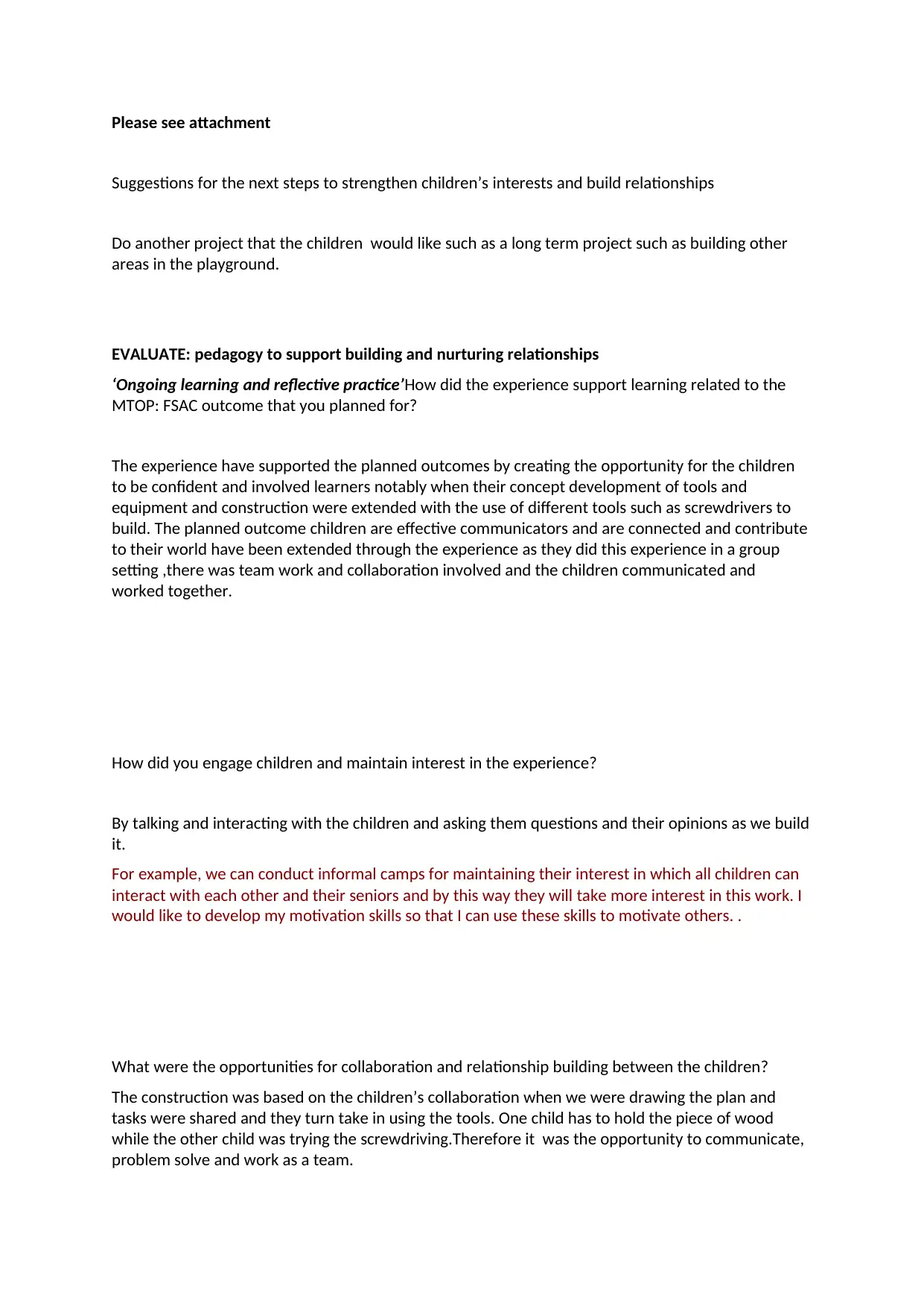
Please see attachment
Suggestions for the next steps to strengthen children’s interests and build relationships
Do another project that the children would like such as a long term project such as building other
areas in the playground.
EVALUATE: pedagogy to support building and nurturing relationships
‘Ongoing learning and reflective practice’How did the experience support learning related to the
MTOP: FSAC outcome that you planned for?
The experience have supported the planned outcomes by creating the opportunity for the children
to be confident and involved learners notably when their concept development of tools and
equipment and construction were extended with the use of different tools such as screwdrivers to
build. The planned outcome children are effective communicators and are connected and contribute
to their world have been extended through the experience as they did this experience in a group
setting ,there was team work and collaboration involved and the children communicated and
worked together.
How did you engage children and maintain interest in the experience?
By talking and interacting with the children and asking them questions and their opinions as we build
it.
For example, we can conduct informal camps for maintaining their interest in which all children can
interact with each other and their seniors and by this way they will take more interest in this work. I
would like to develop my motivation skills so that I can use these skills to motivate others. .
What were the opportunities for collaboration and relationship building between the children?
The construction was based on the children’s collaboration when we were drawing the plan and
tasks were shared and they turn take in using the tools. One child has to hold the piece of wood
while the other child was trying the screwdriving.Therefore it was the opportunity to communicate,
problem solve and work as a team.
Suggestions for the next steps to strengthen children’s interests and build relationships
Do another project that the children would like such as a long term project such as building other
areas in the playground.
EVALUATE: pedagogy to support building and nurturing relationships
‘Ongoing learning and reflective practice’How did the experience support learning related to the
MTOP: FSAC outcome that you planned for?
The experience have supported the planned outcomes by creating the opportunity for the children
to be confident and involved learners notably when their concept development of tools and
equipment and construction were extended with the use of different tools such as screwdrivers to
build. The planned outcome children are effective communicators and are connected and contribute
to their world have been extended through the experience as they did this experience in a group
setting ,there was team work and collaboration involved and the children communicated and
worked together.
How did you engage children and maintain interest in the experience?
By talking and interacting with the children and asking them questions and their opinions as we build
it.
For example, we can conduct informal camps for maintaining their interest in which all children can
interact with each other and their seniors and by this way they will take more interest in this work. I
would like to develop my motivation skills so that I can use these skills to motivate others. .
What were the opportunities for collaboration and relationship building between the children?
The construction was based on the children’s collaboration when we were drawing the plan and
tasks were shared and they turn take in using the tools. One child has to hold the piece of wood
while the other child was trying the screwdriving.Therefore it was the opportunity to communicate,
problem solve and work as a team.
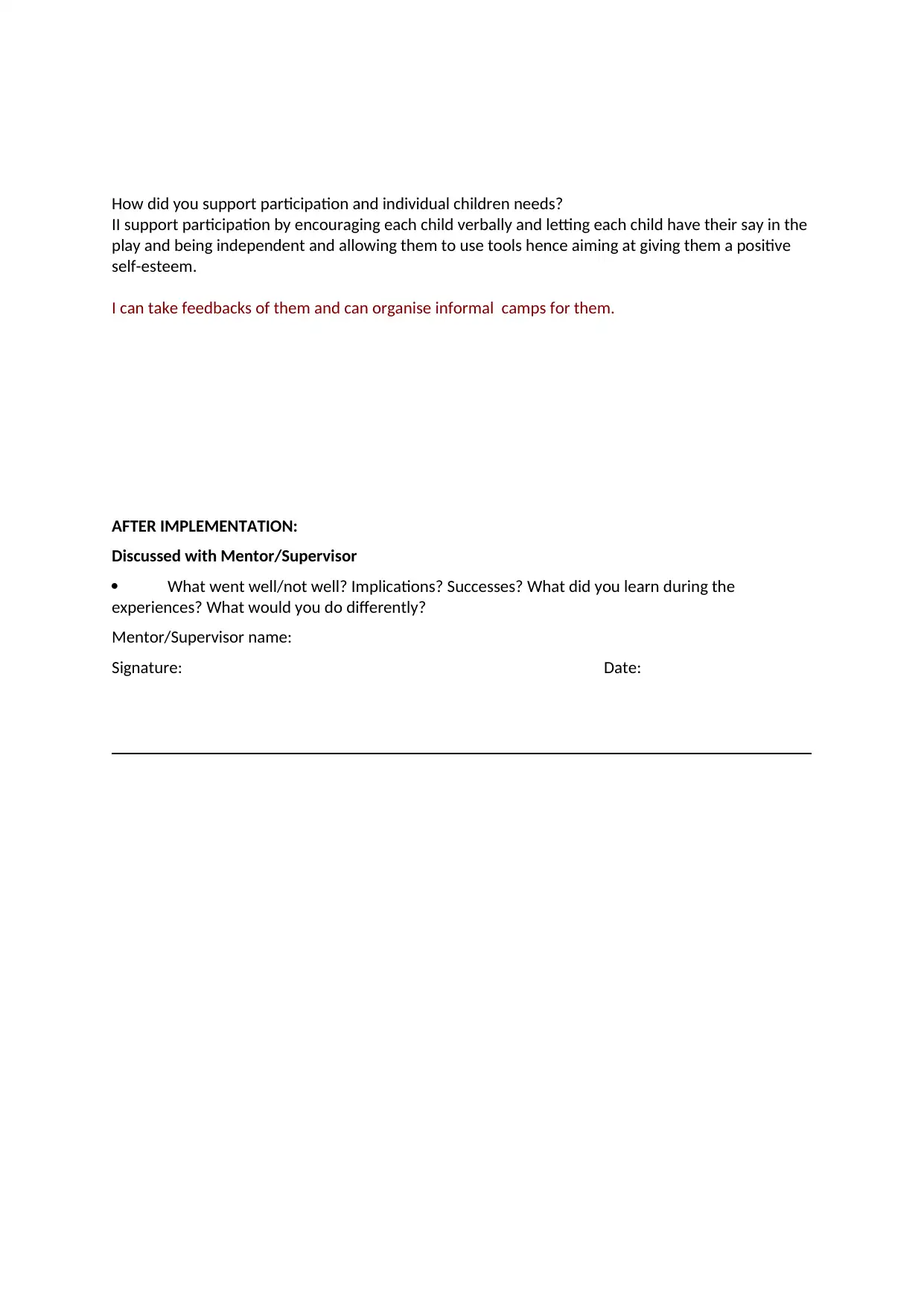
How did you support participation and individual children needs?
II support participation by encouraging each child verbally and letting each child have their say in the
play and being independent and allowing them to use tools hence aiming at giving them a positive
self-esteem.
I can take feedbacks of them and can organise informal camps for them.
AFTER IMPLEMENTATION:
Discussed with Mentor/Supervisor
What went well/not well? Implications? Successes? What did you learn during the
experiences? What would you do differently?
Mentor/Supervisor name:
Signature: Date:
II support participation by encouraging each child verbally and letting each child have their say in the
play and being independent and allowing them to use tools hence aiming at giving them a positive
self-esteem.
I can take feedbacks of them and can organise informal camps for them.
AFTER IMPLEMENTATION:
Discussed with Mentor/Supervisor
What went well/not well? Implications? Successes? What did you learn during the
experiences? What would you do differently?
Mentor/Supervisor name:
Signature: Date:
⊘ This is a preview!⊘
Do you want full access?
Subscribe today to unlock all pages.

Trusted by 1+ million students worldwide
1 out of 6
Related Documents
Your All-in-One AI-Powered Toolkit for Academic Success.
+13062052269
info@desklib.com
Available 24*7 on WhatsApp / Email
![[object Object]](/_next/static/media/star-bottom.7253800d.svg)
Unlock your academic potential
Copyright © 2020–2025 A2Z Services. All Rights Reserved. Developed and managed by ZUCOL.





